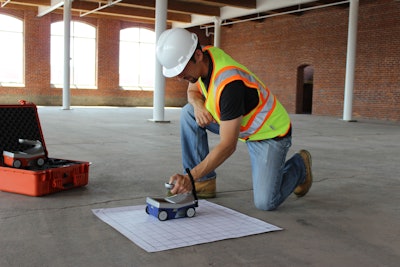Comprehensive Overview to Concrete Scanning Technologies
Comprehensive Overview to Concrete Scanning Technologies
Blog Article
Reveal the Transformative Power of Concrete Scanning in Optimizing Performance and Safety
Concrete scanning has become a vital tool in the building and construction industry, using exceptional benefits in boosting project efficiency and ensuring security criteria. By utilizing innovative modern technology, concrete scanning permits professionals to see beyond the surface, revealing hidden complexities that might affect the structural integrity of a structure. The transformative power of concrete scanning hinges on its capacity to give real-time information and comprehensive understandings, revolutionizing how projects are planned and carried out. As we explore the details of this ingenious method, a globe of opportunities opens up, showcasing a brand-new period of construction practices that focus on accuracy and security.
Significance of Concrete Scanning
Guaranteeing the architectural integrity and safety and security of building projects begins with the crucial step of carrying out complete concrete scanning. Concrete scanning is a non-destructive technique used to discover and map subsurface elements within concrete structures.
In addition, concrete scanning aids in enhancing task timelines and budget by preventing unforeseen expenses and hold-ups that might develop due to unexpected blockages within the concrete. Inevitably, investing in comprehensive concrete scanning is a positive technique that boosts both efficiency and safety in construction projects.
Just How Concrete Scanning Functions
Concrete scanning operates as a crucial device in building and construction jobs by using advanced innovations to spot and map subsurface aspects without causing structural damages. Ground Penetrating Radar (GPR) and Electromagnetic Induction (EMI) are two key techniques utilized in concrete scanning. GPR works by discharging high-frequency radar pulses right into the surface, which recuperate when they come across subsurface things or gaps. The moment taken for the signal to return indicates the deepness and place of the items. EMI, on the various other hand, makes use of electro-magnetic fields to recognize variances in product make-ups, such as recognizing rebar or avenues within concrete structures.
Throughout the scanning process, the information gathered is analyzed in real-time, enabling instant identification of potential dangers or challenges underneath the surface area. By using these advanced modern technologies, concrete scanning considerably decreases the risk of costly damages and injuries on building websites.
Benefits of Concrete Scanning
One of the primary benefits of concrete scanning is the capacity to discover and situate ingrained objects such as rebar, post-tension cords, and avenues accurately. Concrete scanning aids in planning and developing extra properly, as it gives accurate info regarding the area and deepness of architectural components.

Study: Concrete Scanning Success

In an additional case, a building and construction business made use of 3D concrete scanning to assess the condition of aging concrete structures in a historical building. The thorough scans provided important insights right into the extent of damage and assisted focus on maintenance initiatives properly. By proactively addressing locations of issue identified through scanning, the firm had the ability to prolong the life-span of the structure and guarantee occupant safety.
These instance studies highlight the transformative power of concrete scanning in boosting performance, precision, and security in building tasks.
Carrying Out Concrete Scanning in Projects
Carrying out advanced scanning modern technologies during building and construction projects has actually ended up being increasingly essential for improving accuracy and safety. By incorporating concrete scanning right into job preparation and implementation, building groups can identify prospective hazards, such as rebar or post-tension wires, hidden within concrete structures. This proactive strategy reduces the danger of crashes, delays, and costly rework, ultimately resulting in a lot more reliable task timelines and budget plans.
To apply concrete scanning successfully, task supervisors must team up very closely with experienced scanning professionals to establish the most appropriate scanning strategies for the certain task demands. Engaging scanning specialists from the beginning of a task enables the team to develop thorough scanning strategies that deal with key locations of issue and make sure extensive data collection.
In addition, incorporating concrete scanning into routine task workflows can simplify decision-making procedures, as real-time scan this contact form data gives prompt understandings right into the condition of concrete structures - Concrete Scanning. This data-driven method assists in educated analytical and allows teams to make changes without delay, promoting a culture of effectiveness and safety and security throughout the job lifecycle

Conclusion
Finally, concrete scanning plays a crucial role in boosting efficiency and safety in construction tasks. By making use of advanced innovation to map and detect out underlying go to my blog structures within concrete, this procedure helps to avoid expensive errors, ensure structural honesty, and minimize threats on website. With the ability to discover covert components and supply exact data, concrete scanning verifies to be a useful device for enhancing project end results and optimizing general success.
Concrete scanning is a non-destructive technique utilized to discover and map subsurface aspects within concrete frameworks. In addition, concrete scanning assists in optimizing job timelines and spending plan by preventing unforeseen expenses and delays that may emerge due to unanticipated obstructions within the concrete. One significant situation research entails a large restoration task where concrete scanning played an important duty in making certain job success.In another instance, a building company used 3D concrete scanning to analyze the problem of aging concrete frameworks in a historic pop over to this web-site building. By integrating concrete scanning right into task planning and implementation, building and construction groups can identify potential threats, such as rebar or post-tension cables, concealed within concrete structures.
Report this page